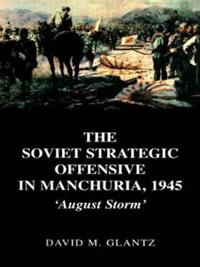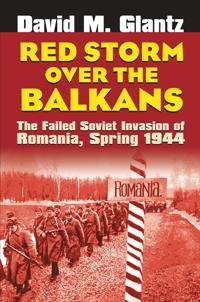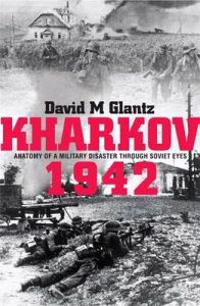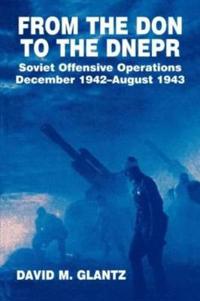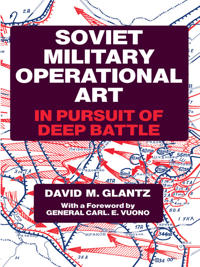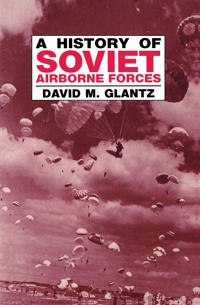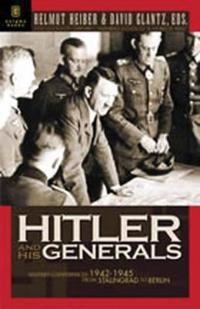When Titans Clashed (Inbunden)
avDavid M. Glantz, Jonathan M. House
ISBN: 9780700608997 - UTGIVEN: 199802By the time Pearl Harbor had ripped apart America's peacetime pretensions, the German blitzkrieg had already blasted the Red Army back to the gates of Moscow. Yet, less than four years later, the Soviet hammer-and-sickle flew above the ruins of Berlin, stark symbol of a miraculous comeback that dest[...]
The Battle of Kursk (Häftad)
avDavid M. Glantz, Jonathan M. House
ISBN: 9780700613359 - UTGIVEN: 199910Immense in scope, ferocious in nature, and epic in consequence, the Battle of Kursk witnessed (at Prokhorovka) one of the largest tank engagements in world history and led to staggering losses-including nearly 200,000 Soviet and 50,000 German casualties-within the first ten days of fighting. Going w[...]
The Soviet Strategic Offensive in Manchuria, 1945 (Pocket)
avDavid M. Glantz
ISBN: 9780415408615 - UTGIVEN: 2003-02This critical examination of the final Soviet strategic offensive operation during World War II seeks to chip away at two generally inaccurate pictures many Westerners have of the war. Specifically, Westerners seem to think that only geography, climate, and sheer numbers negated German military ski[...]
The Battle for Leningrad, 1941-1944 (Inbunden)
avDavid M. Glantz
ISBN: 9780700612086 - UTGIVEN: 200211The German seige and Soviet defense of Leningrad in World War II was an epic struggle in an epic war, a drama of heroism and human misery unmatched in the annals of modern warfare. This work provides a military history of the conflict waged beyond the city's borders. One of the first major Soviet ci[...]
Red Storm Over the Balkans (Inbunden)
avDavid M. Glantz
ISBN: 9780700614653 - UTGIVEN: 200612Germany's Eastern Front in World War II saw many campaigns and battles that have been "forgotten" by a Soviet Union that tried to hide its military failures. The Red Army's invasion of Romania in April and May 1944 was one such campaign, which produced nearly 200,000 casualties and tarnished the rep[...]
Armageddon in Stalingrad (Inbunden)
avDavid M. Glantz
ISBN: 9780700616640 - UTGIVEN: 200912The German offensive on Stalingrad was originally intended to secure the Wehrmacht's flanks, but it stalled dramatically in the face of Stalin's order: 'Not a Step Back!' The Soviets' resulting tenacious defense of the city led to urban warfare for which the Germans were totally unprepared, deprivin[...]
Endgame at Stalingrad, Book One (Inbunden)
avDavid M Glantz
ISBN: 9780700619542 - UTGIVEN: 2014-05The campaign intended to secure the Wehrmacht's flanks had proven one front too many for the German Army. And now the offensive at Stalingrad, the epic clash that marked Germany's failure on the Eastern Front, was entering its grim final phase. In Book One of the third volume of his acclaimed "Stali[...]
Endgame at Stalingrad, Book Two (Inbunden)
avDavid M Glantz
ISBN: 9780700619559 - UTGIVEN: 2014-05In "Book Two" of the third volume of his magisterial "Stalingrad Trilogy," David Glantz continues and concludes his definitive history of one of the most infamous battles of World War Two, the Stalingrad campaign that signaled Germany's failure on the Eastern Front and marked a turning point in the [...]
Companion to Endgame at Stalingrad (Inbunden)
avDavid M Glantz
ISBN: 9780700619566 - UTGIVEN: 2014-05In "Endgame at Stalingrad," the final volume of his acclaimed "Stalingrad Trilogy," David Glantz completes his definitive account of one of World War II's most infamous confrontations, the campaign that marked Germany's failure on the Eastern Front and proved to be a turning point in the war. In doc[...]
Kharkov 1942 (Pocket)
avDavid M. Glantz
ISBN: 9780711034686 - UTGIVEN: 201001In May 1942, the powerful German Wehrmacht and the massive Soviet Red Army were engaged in a bitter struggle. The initially rapid advance of the Wehrmacht deep into the Soviet Union against the Red Army had been halted by the spring of 1941. Red Army counter-offensives had stopped the German advance[...]
From the Don to the Dnepr (Pocket)
avDavid M. Glantz
ISBN: 9780714640648 - UTGIVEN: 1990-06This book provides an in-depth study of the Soviet Army during the offensive operations that started with Battle of Stalingrad in December 1942 and went until Spring 1943. The lessons learned by the Soviet Army from these experiences helped design the military steamroller that decimated the German p[...]
Soviet Military Operational Art (Häftad)
avDavid M. Glantz
ISBN: 9780714640778 - UTGIVEN: 199101David Glantz examines the Soviet study of war, the re-emergence of the operation level and its connection with deep battle, the evolution of the Soviet theory of operations in depth before 1941, and its refinement and application in the European theatre and the Far East between 1941 and 1945.[...]
A History of Soviet Airborne Forces (Häftad)
avDavid M. Glantz
ISBN: 9780714641201 - UTGIVEN: 1994-11For almost 70 years Soviet and Russian military theorists have been fascinated with the concept of airborne operations. Now Russian theorists tackle the problems posed to such operations by high-precision weaponry. This work, using newly released and formerly classified Soviet and East German archiv[...]
The Battle For Kursk, 1943 (Pocket)
avDavid M. Glantz, Harold S. Orenstein
ISBN: 9780714644936 - UTGIVEN: 1999-09-29As a treasure trove of fresh material, this book addresses aspects of the Battle of Kursk that have puzzled commentators since 1943.[...]
Operation Barbarossa (Häftad)
avDavid M. Glantz
ISBN: 9780752460703 - UTGIVEN: 201105David Glantz challenges the time-honoured explanation that poor weather, bad terrain and Hitler's faulty strategic judgement produced German defeat, and reveals how the Red Army thwarted the German Army's dramatic and apparently inexorable invasion before it achieved its ambitious goals.
[...]Barbarossa Derailed: The Battle for Smolensk 10 July-10 September 1941 (Inbunden)
avDavid M. Glantz
ISBN: 9781906033903 - UTGIVEN: 201105At dawn on 10 July 1941, massed tanks and motorized infantry of German Army Group Center's Second and Third Panzer Groups crossed the Dnepr and Western Dvina Rivers, beginning what Adolf Hitler, the Fuhrer of Germany's Third Reich, and most German officers and soldiers believed would be a triumphal [...]
After Stalingrad (Häftad)
avDavid M. Glantz
ISBN: 9781907677052 - UTGIVEN: 201106In the wake of the Red Army's signal victory at Stalingrad, which began when its surprise counteroffensive encircled German Sixth Army in Stalingrad region in mid-November 1942 and ended when its forces liquidated beleaguered Sixth Army in early February 1943, the Soviet High Command (Stavka) expand[...]
Barbarossa Derailed. The Battle for Smolensk 10 July-10 September 1941 (Inbunden)
avDavid M. Glantz
ISBN: 9781909982116 - UTGIVEN: 2014-09Volume 3, the Documentary Companion to Barbarossa Derailed, contains the documentary evidence for the two volumes of narrative. In addition to key Fuhrer Directives issued by Adolf Hitler to provide direction to his forces during the Barbarossa Campaign, as well as vital orders issued by German Army[...]
Hitler And His Generals (Pocket)
avGerhard L. Weinberg, Helmut Heiber, David M. Glantz
ISBN: 9781929631285 - UTGIVEN: 200412In the late summer of 1942 Hitler ordered that stenographers take down every word that was uttered during the twice-daily military conferences. Of the more than 103,000 pages recorded less than 1,000 pages survived destruction in May 1945 and make up the material of this book. A truly definitive wor[...]
Through the Maelstrom (Pocket)
avBoris Gorbachevsky, Stuart (TRN) Britton, David M. (FRW) Glantz
ISBN: 9780700621071 - UTGIVEN: 2015-03The monumental battles of World War II's Eastern FrontuMoscow, Stalingrad, Kurskuare etched into the historical record. But there is another, hidden history of that war that has too often been ignored in official accounts. Boris Gorbachevsky was a junior officer in the 31st Army who first saw front-[...]



